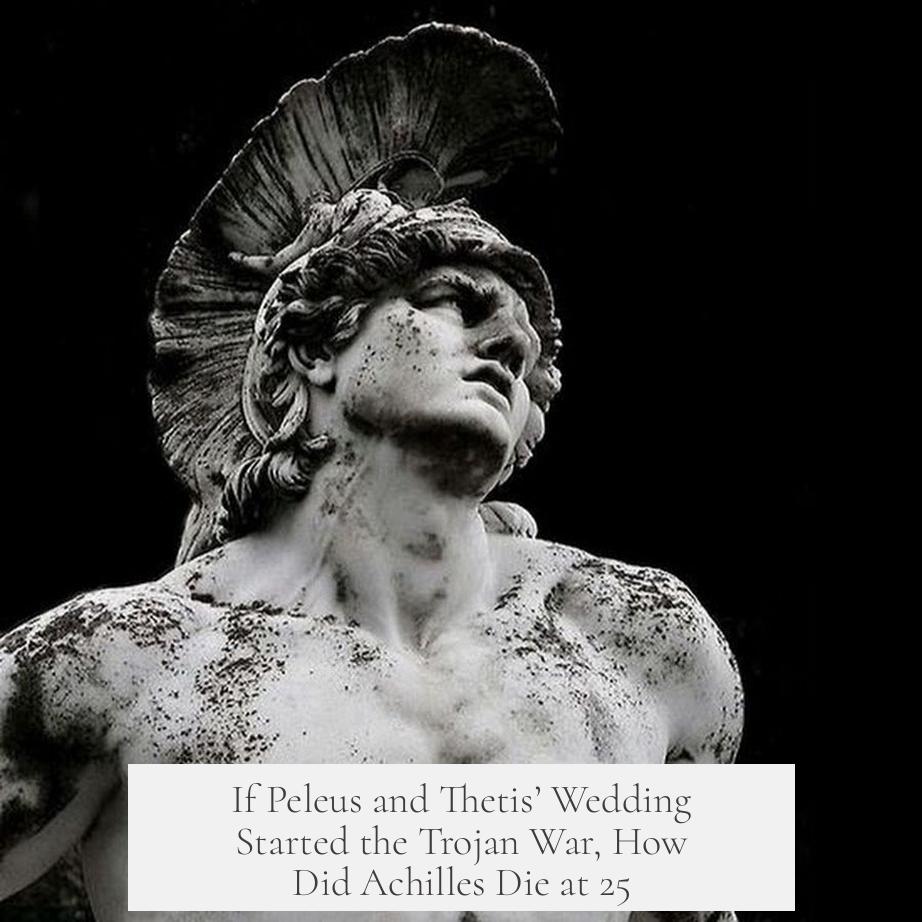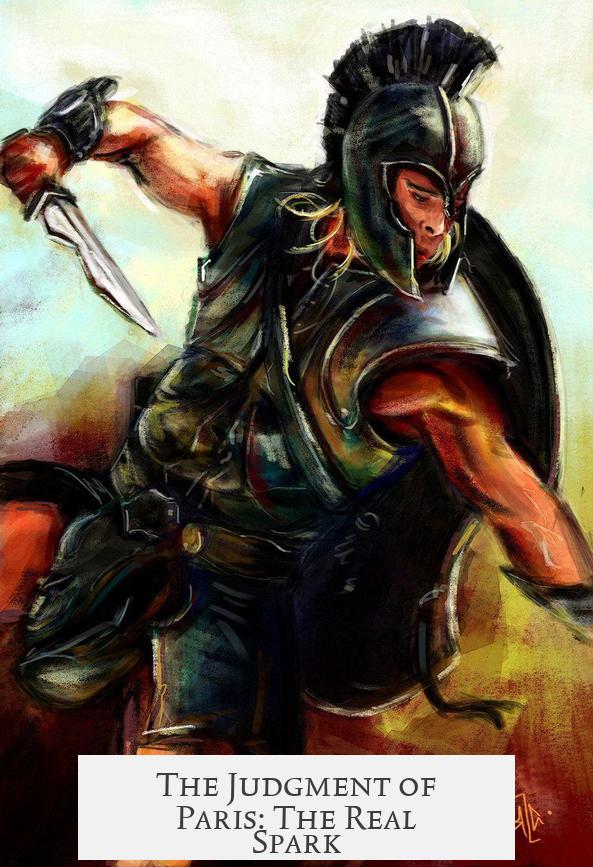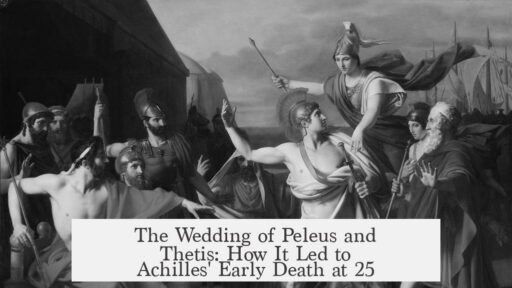The wedding of Peleus and Thetis did not directly start the Trojan War, which explains how Achilles could die at 25 despite that event initiating the conflict’s mythological chain. The wedding acted as a catalyst but preceded the war by over a decade, allowing time for Achilles to be born, grow, and fight.
The wedding features prominently because it led to the infamous “Judgment of Paris.” At the feast, the goddess Eris tossed the golden apple marked “For the fairest,” sparking a divine dispute. Paris eventually awarded the apple to Aphrodite, who promised him Helen’s love. This decision results in Helen’s abduction (or elopement), a key trigger for the Trojan War.
However, there is an implicit time gap between the wedding and the outbreak of war. This span could last ten to fifteen years, covering the period between Helen’s abduction and the Greek coalition assembling to lay siege to Troy.
- Achilles was born to Peleus and Thetis after the wedding, during this lull.
- The war’s preparation required time to gather allies, armies, and resources.
- Mythical timelines focus on storytelling, not strict chronology.
This gap lets Achilles grow to roughly 15-20 years by the war’s start. Ancient prophecies foretell his young and glorious death, which aligns with the tradition that he dies around age 25 during the conflict.
Alternative versions, such as the Helen-in-Egypt narrative, suggest Helen was absent for much of the war, indicating that the timeline and events contain flexible interpretations.
In summary, the wedding’s role is key but indirect. The timeline unfolds as follows:
- The wedding of Peleus and Thetis.
- The Judgment of Paris and Helen’s abduction.
- A span of years for war preparations and Achilles’ maturation.
- The Trojan War begins with mature heroes, including Achilles around 15-20.
- Achilles dies young, near 25, during the war.
This sequencing reconciles the mythological events and explains the timeline of Achilles’ death well after the wedding.
- The wedding marks the start but not immediate outbreak of war.
- Significant time passes for Achilles’ birth and growth.
- War preparation requires years, delaying conflict.
- Achilles’s age fits prophecy and myth of a young warrior’s death.
- The mythology timeline prioritizes story over exact years.
If Peleus and Thetis’ Wedding Started the Trojan War, How Did Achilles Die at 25?

The wedding of Peleus and Thetis didn’t spark the Trojan War right away. Instead, it’s the opening note of a longer, complex symphony that ultimately leads to the epic conflict. Achilles’ death at 25 makes perfect sense once we unpack the timeline and mythological context.
If you’re wondering how the event that started it all—the wedding of Peleus and Thetis—relates to Achilles’ young demise, you’re not alone. Let’s unravel this ancient puzzle step by step, with a splash of humor and plenty of “aha” moments.
The Wedding That Set Things in Motion

Picture this: Peleus and Thetis tie the knot—a divine and mortal love story. But wait! This isn’t just any party. The gods show up, and Eris, the goddess of discord, crash-lands with a golden apple labeled “To the Fairest.”
This harmless disruption plants the seeds for drama but doesn’t burst the Trojan War balloon immediately. Instead, it leads to the famous Judgment of Paris, where Paris is asked to pick the fairest goddess among Hera, Athena, and Aphrodite.
The Judgment of Paris: The Real Spark

Paris picks Aphrodite, swayed by the promise of Helen’s hand (or, let’s say, the ultimate “wife upgrade”). Helen, renowned as the most beautiful woman, ends up in Troy—via abduction or elopement depending on your preferred myth version.
This event happens some time after the wedding. As spectacular as Peleus and Thetis’ wedding was, the war’s *true* ignition point is Helen’s fateful move to Troy.
A Peaceful Interlude and Achilles’ Birth

Here’s where the timeline gets juicy. There’s a significant gap—a stretch of peace—between Helen leaving Sparta and the Trojan War officially kicking off. This pause can be a decade or more. It’s during this quiet time that Achilles is born to Peleus and Thetis and grows from a baby wrapped in divine blankets to a finely honed warrior.
Without this pause, it would be impossible for Achilles to be the young hero he is at Troy. Ancient stories sometime skip the boring bits (baby giggles and toddler tantrums) and jump straight to the heroics.
Why Does Mythology Play Fast and Loose with Time?

One must remember, Greek myths are more poem than history textbook. The timeline isn’t strict. It’s like watching a movie that jumps between scenes without an explicit timestamp. The story focuses on the excitement and drama—less on the exact timing.
Therefore, when you see Achilles in his prime at Troy, don’t get hung up on the gap between the wedding and the war. It’s a mythological convenience so the story flows, ensuring Achilles is the star we remember.
Preparing for War Takes Time
Let’s be real. Launching a war against a fortified city like Troy isn’t a weekend hobby. The Greeks had to gather armies, coordinate fleets, and convince reluctant allies. Historically and mythologically, this preparation can stretch for years.
When you factor in the time to pack, plan, and duel over who gets the last grape, the decade-plus delay before the Trojan War starts becomes a lot more logical.
Achilles at War and His Glorious Fate
Now to Achilles, that lightning bolt of a hero. If the war began when Achilles was around 15 to 20 years old, this fits the prophecy about his short but glorious life perfectly. The teenager grows into the unmatched warrior we read about in Homer’s epics.
Achilles’ death at 25 isn’t some rushed, afterthought event. It’s the climax of his mythic journey, framed by the wartime events that unfolded years after the wedding that started it all.
Piecing the Mythological Timeline Together
To reconcile the timeline:
- The wedding of Peleus and Thetis sets the stage but does not start the war.
- The Judgment of Paris and Helen’s departure escalate tensions.
- There is a gap—potentially 10 to 15 years—between these events and the Trojan War’s outbreak.
- During this interval, Achilles is born and grows up.
- The Greeks prepare their forces, then launch the war when Achilles is a fighting man.
This sequence allows for all mythic pieces to fit without contradiction.
A Different Take on Helen’s Role
For a twist, some legends say Helen never reached Troy, instead spending the entire war safely in Egypt. Menelaus supposedly meets her there after the war, courtesy of divine intervention.
While this version flies under the radar in popular retellings, it adds flavor and complexity to the timeline. If Helen wasn’t at Troy, mistrust, politics, and other provocations could have kept the war going, maintaining the needs for heroes like Achilles to fight and die young.
Why Does All This Matter Today?
Understanding this timeline sheds light on how myths are crafted—not as strict histories but as stories to inspire, instruct, and entertain.
For modern readers, it reminds us that Achilles’ death at 25 is consistent when the gap between events is acknowledged. It reinforces that myth is less about literal dates and more about the resonance of heroic deeds.
If you ever find yourself pondering the gaps in other mythic or historical stories, remember: Sometimes, the “missing years” are where all the real magic happens.
Curious for More?
For a dive into how ancient storytellers “played fast and loose” with the Trojan War timeline, you might visit discussions like this Reddit post. It explains why flexibility in chronology is a hallmark of epic storytelling.
And if timelines frustrate you, just remember: Even heroes need a few years to grow up before they can grab a spear and enter legend.
How does the wedding of Peleus and Thetis connect to the start of the Trojan War?
The wedding was the origin of a chain of events. It led to the judgment of Paris, where Eris’ golden apple caused discord. This began a series of actions ending in Helen’s abduction, sparking the Trojan War years later.
Why is there a time gap between the wedding and the Trojan War?
The gap allows for Achilles’ birth and growth. It also accounts for the time needed to prepare forces and resources. Mythological timelines focus on story flow over strict dates, so the war starts about 10-15 years after the wedding.
How old was Achilles when the Trojan War began and died?
Achilles was likely 15-20 when the war started. He died at about 25 years old. This fits the prophecy of his brief but glorious life.
Why doesn’t the mythology give exact years between events?
Mythology prioritizes narrative over precise timing. The timeline jumps to focus on key events, leaving gaps for interpretation. This style helps tell heroic tales without strict chronology.
What role did the judgment of Paris play in the war’s timeline?
Paris’ choice of Aphrodite over Hera and Athena led to Helen’s abduction. This choice happened after the wedding, setting off tensions leading to war. The decision adds meaning to the timeline’s progression.
Could Helen have been somewhere else during the war?
Some versions say Helen was taken to Egypt during the war, staying safe until the end. This perspective changes the story but keeps the war’s timeline intact in mythology.



